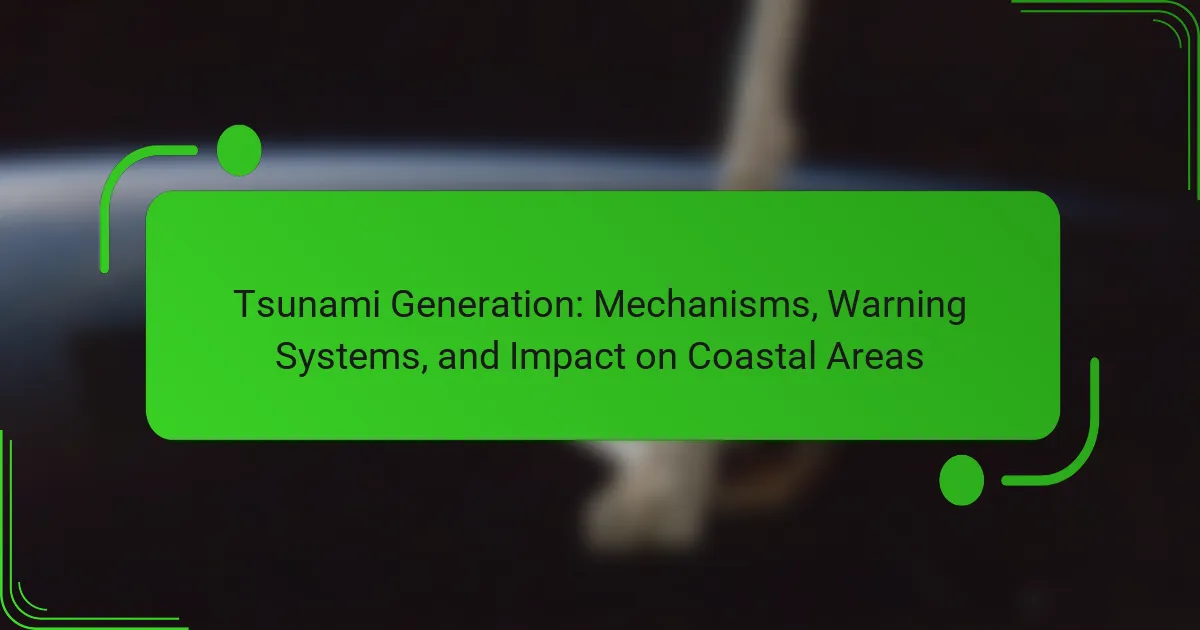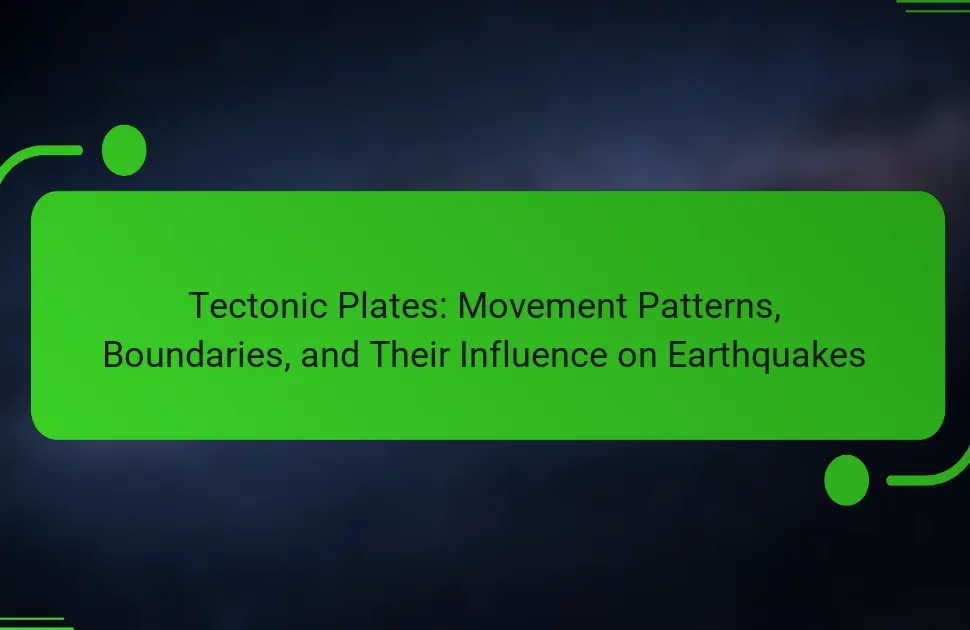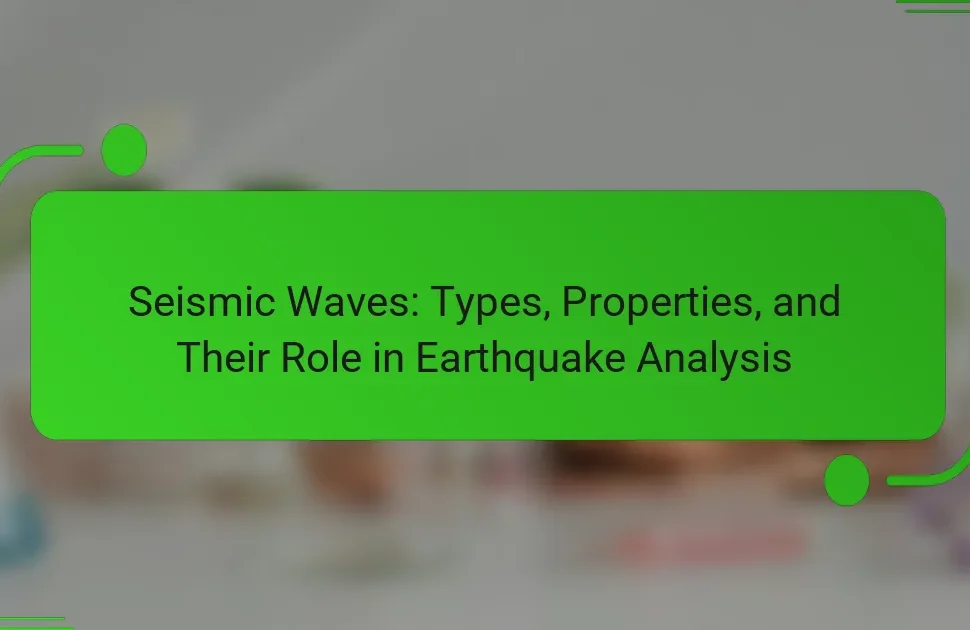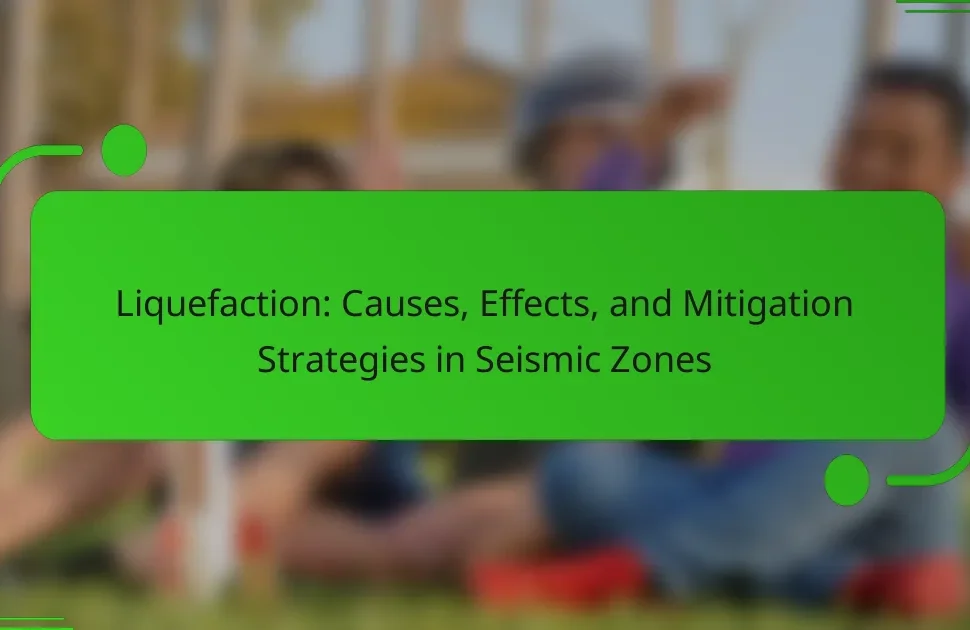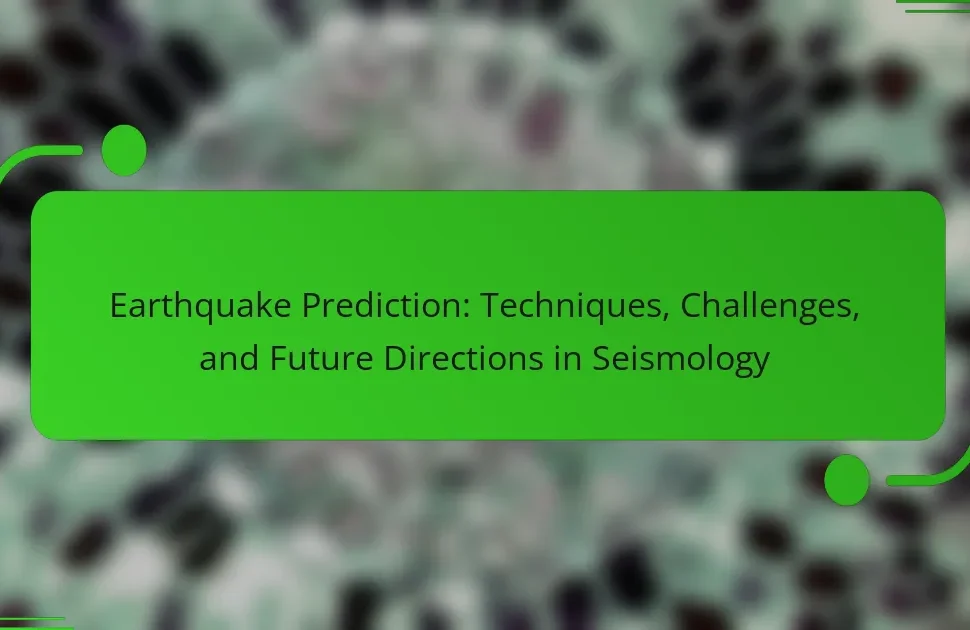Tsunami generation is the process by which large ocean waves are created, primarily due to underwater disturbances such as seismic activities, volcanic eruptions, and landslides. These disturbances often result from tectonic earthquakes, which displace significant volumes of water, leading to the formation of tsunami waves that can travel rapidly across the ocean. As these waves approach shallower coastal areas, they slow down and can increase dramatically in height, posing significant risks to coastal communities. Effective tsunami warning systems, including seismic monitoring, ocean buoys, and coastal sirens, are essential for detecting potential tsunamis and alerting populations to impending threats. This article explores the mechanisms of tsunami generation, the technologies used in warning systems, and the potential impacts on coastal regions.
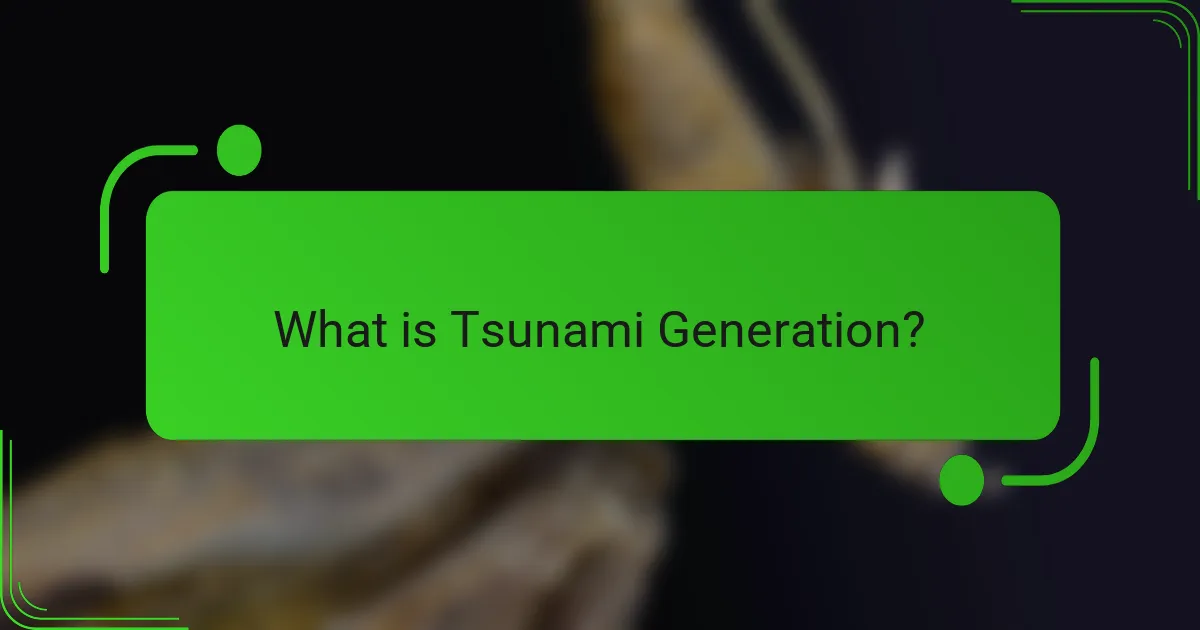
What is Tsunami Generation?
Tsunami generation refers to the process that creates tsunamis, which are large ocean waves typically caused by underwater disturbances. These disturbances often include seismic activities such as earthquakes, volcanic eruptions, or landslides. When tectonic plates shift, they can displace large volumes of water, leading to the formation of tsunamis. The energy released during these events travels through the ocean, creating waves that can grow in height as they approach coastal areas. Historical data shows that approximately 80% of tsunamis are triggered by earthquakes. The most powerful tsunamis can reach heights of over 30 meters when they hit shorelines.
How do tsunamis form in nature?
Tsunamis form in nature primarily due to underwater disturbances. These disturbances often include earthquakes, volcanic eruptions, or landslides. The most common cause is an earthquake occurring along tectonic plate boundaries. When tectonic plates shift, they displace large volumes of water. This displacement generates waves that travel across the ocean.
Tsunami waves can reach speeds of up to 500 miles per hour in deep water. As these waves approach shallower coastal areas, they slow down and increase in height. The energy from the displaced water is transferred to the waves, leading to potentially devastating impacts upon landfall. Historical events, such as the 2004 Indian Ocean tsunami, demonstrate the destructive power of tsunamis formed from seismic activity.
What geological processes lead to tsunami generation?
Tsunamis are generated primarily by geological processes such as underwater earthquakes, volcanic eruptions, and landslides. Underwater earthquakes occur when tectonic plates shift, displacing large volumes of water. This displacement creates waves that travel across the ocean. For instance, the 2004 Indian Ocean tsunami was triggered by a magnitude 9.1 earthquake. Volcanic eruptions can also displace water, particularly when an eruption causes a significant collapse or explosion. Landslides, both underwater and from coastal cliffs, can generate tsunamis by rapidly displacing water. Historical data shows that these geological activities are responsible for the majority of tsunami events worldwide.
How do underwater earthquakes contribute to tsunamis?
Underwater earthquakes contribute to tsunamis by displacing large volumes of water. This displacement occurs when tectonic plates shift along fault lines beneath the ocean. The sudden movement creates waves that travel outward from the earthquake’s epicenter. These waves can grow in height as they approach shallow coastal areas. Historical data shows that approximately 80% of tsunamis are triggered by underwater earthquakes. For instance, the 2004 Indian Ocean tsunami was caused by a magnitude 9.1 earthquake off the coast of Sumatra. Such events demonstrate the direct link between underwater seismic activity and tsunami generation.
What types of tsunamis exist?
There are several types of tsunamis. The main types include seismic, landslide, volcanic, and meteorological tsunamis. Seismic tsunamis are caused by underwater earthquakes. They account for the majority of tsunamis. Landslide tsunamis occur when large amounts of debris fall into the ocean. Volcanic tsunamis result from volcanic eruptions or the collapse of volcanic islands. Meteorological tsunamis, also known as meteotsunamis, are generated by atmospheric pressure changes. Each type of tsunami has distinct characteristics and causes. Understanding these types is crucial for effective warning systems and disaster preparedness.
How do tectonic tsunamis differ from other types?
Tectonic tsunamis differ from other types primarily due to their origin. They are generated by underwater earthquakes or volcanic eruptions that displace large volumes of water. This displacement occurs along tectonic plate boundaries where stress builds up and is released suddenly. Other types of tsunamis, such as those caused by landslides or meteorite impacts, have different mechanisms of generation. For instance, landslide tsunamis result from the sudden collapse of land into the ocean. Tectonic tsunamis can travel across entire ocean basins, often reaching heights of over 100 feet upon landfall. In contrast, tsunamis from landslides are generally localized and less powerful. Historical data shows that the 2004 Indian Ocean tsunami, a tectonic tsunami, resulted from a magnitude 9.1 earthquake, causing widespread devastation. This illustrates the significant energy release associated with tectonic tsunamis compared to other types.
What role do landslides play in tsunami generation?
Landslides can generate tsunamis by displacing large volumes of water. When a landslide occurs near or under the ocean, it can create a sudden shift in water levels. This displacement leads to the formation of waves. The energy from the landslide transfers to the water, resulting in tsunami waves. Historical events, such as the 1958 Lituya Bay tsunami, demonstrate this phenomenon. In that case, a massive landslide triggered a wave over 500 meters high. Such waves can travel across oceans, impacting distant shores. Thus, landslides play a significant role in tsunami generation through water displacement.
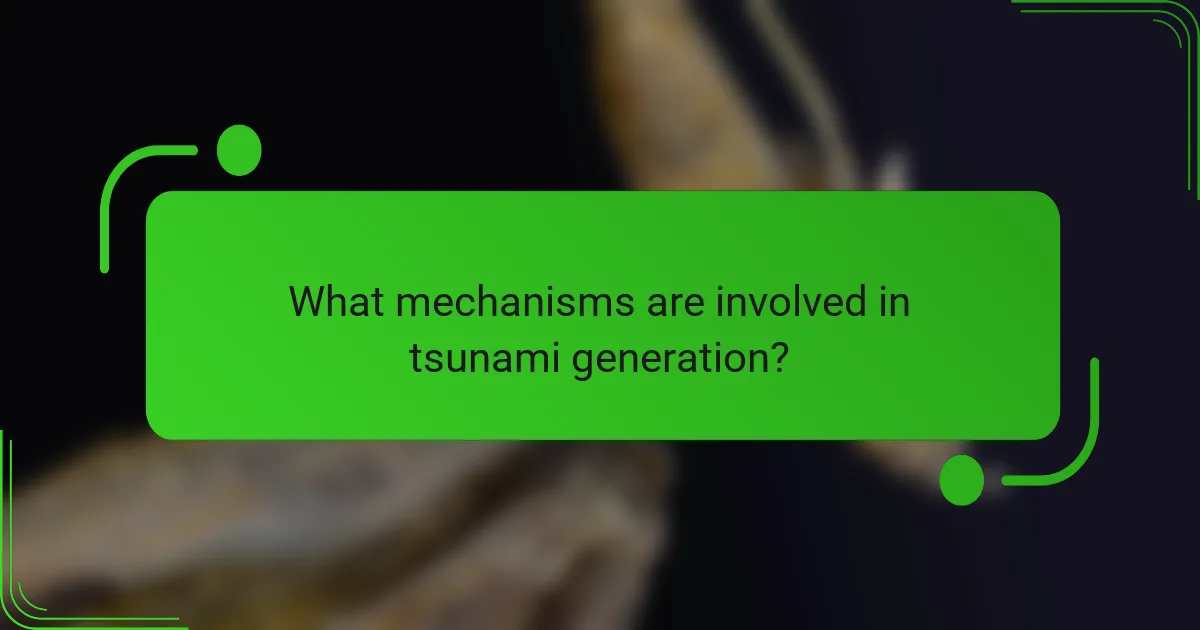
What mechanisms are involved in tsunami generation?
Tsunamis are generated primarily by underwater disturbances. These disturbances include seismic activity, volcanic eruptions, and landslides. The most common mechanism is tectonic earthquakes. When tectonic plates shift, they displace large volumes of water. This displacement creates waves that travel across the ocean.
Volcanic eruptions can also trigger tsunamis. An explosive eruption can send debris into the water, causing waves. Underwater landslides, often triggered by earthquakes, can similarly displace water and generate tsunamis.
The energy from these events propagates outward in all directions. Tsunami waves can travel at speeds of up to 500 to 800 kilometers per hour in deep water. This rapid movement allows them to cover vast distances across oceans.
As the waves approach shallower coastal areas, they slow down and increase in height. This process can lead to dangerous and destructive tsunami waves when they reach land.
How does the seafloor movement affect tsunami waves?
Seafloor movement significantly affects tsunami waves by displacing large volumes of water. This displacement occurs during underwater earthquakes, volcanic eruptions, or landslides. The sudden shift in the seafloor generates waves that travel outward in all directions. Tsunami waves can reach speeds of over 500 miles per hour in deep water. As these waves approach shallower coastal areas, their speed decreases, but their height increases dramatically. This phenomenon is known as wave shoaling. Historical events, such as the 2004 Indian Ocean tsunami, illustrate how seafloor movement can lead to devastating tsunamis. The earthquake off the coast of Sumatra triggered massive waves that affected multiple countries.
What is the significance of wave height and energy?
Wave height and energy are crucial indicators of ocean wave dynamics. Higher wave heights typically indicate greater energy levels within the waves. This energy is generated by wind, seismic activity, or underwater disturbances. In the context of tsunamis, wave height can escalate dramatically, leading to significant coastal impacts. For instance, a tsunami wave can reach heights of over 30 meters, carrying immense energy capable of causing widespread destruction. Understanding wave height and energy helps in predicting potential hazards and implementing effective warning systems. This knowledge is vital for coastal communities to prepare for and mitigate tsunami risks.
How does wave propagation occur in deep water?
Wave propagation in deep water occurs primarily through the movement of energy across the water surface. In deep water, waves are generated by wind, earthquakes, or other disturbances. The energy from these disturbances travels in the form of waves. These waves have long wavelengths and can travel vast distances without losing energy.
In deep water, the motion of water particles is circular. This circular motion decreases with depth, meaning that deeper water experiences less movement. The speed of wave propagation in deep water is determined by the wavelength. Longer wavelengths travel faster than shorter ones.
Research indicates that deep-water waves can travel at speeds exceeding 30 meters per second. This is significant for understanding tsunami behavior. Tsunamis, generated by underwater earthquakes, can maintain high speeds in deep water, allowing them to cover large oceanic distances rapidly.
What factors influence the strength of a tsunami?
The strength of a tsunami is influenced by several key factors. The most significant factor is the magnitude of the underwater earthquake that generates the tsunami. Earthquakes with a magnitude of 7.0 or higher typically produce more powerful tsunamis. Another factor is the depth of the earthquake’s focus; shallower earthquakes tend to generate stronger tsunamis. Additionally, the geological characteristics of the ocean floor play a role. Steep underwater slopes can amplify tsunami waves. The distance from the earthquake epicenter to the coastline also affects strength; closer proximity results in less time for wave energy to dissipate. Lastly, the interaction of tsunami waves with coastal features can either amplify or diminish their strength upon reaching land.
How does the depth of water affect tsunami impact?
The depth of water significantly affects tsunami impact. In deeper water, tsunamis travel faster and with less energy loss. This allows them to cover vast distances without dissipating. As the tsunami approaches shallower coastal areas, the wave slows down and increases in height. The wave’s energy is compressed, leading to potentially devastating impacts on coastal structures. Historical events, such as the 2004 Indian Ocean tsunami, demonstrate that shallower depths amplify wave heights. In contrast, deeper areas can mitigate the impact by spreading the energy over a larger volume of water. Thus, water depth plays a critical role in determining tsunami behavior and its subsequent effects on coastal regions.
What is the relationship between the epicenter and tsunami intensity?
The epicenter of an earthquake significantly influences tsunami intensity. Tsunamis usually originate from undersea earthquakes. The closer the epicenter is to the coast, the higher the tsunami intensity. For instance, the 2004 Indian Ocean tsunami was caused by a magnitude 9.1 earthquake near Sumatra. This earthquake’s epicenter was only 30 kilometers offshore, leading to devastating waves. Conversely, earthquakes with epicenters far from land generate weaker tsunamis. The intensity diminishes as the distance from the epicenter increases. Research indicates that tsunamis lose energy as they travel across the ocean. Therefore, the epicenter’s location is crucial in determining tsunami impact on coastal areas.
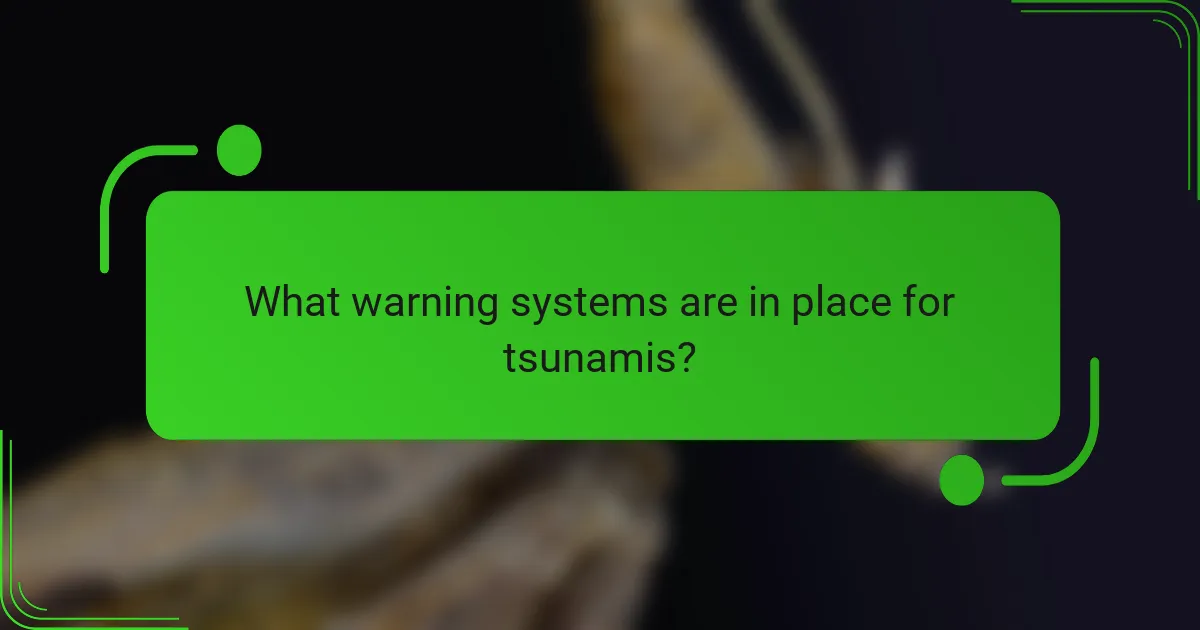
What warning systems are in place for tsunamis?
Tsunami warning systems include seismic monitoring, ocean buoys, and coastal sirens. Seismic monitoring detects earthquakes that may trigger tsunamis. Networks of seismographs provide real-time data on seismic activity. Ocean buoys equipped with sensors measure changes in sea level. These buoys can detect tsunami waves as they travel across the ocean. Coastal sirens alert communities of impending tsunamis. They are activated based on data from seismic and buoy systems. The National Oceanic and Atmospheric Administration (NOAA) operates a comprehensive tsunami warning system in the United States. This system has successfully issued warnings during significant tsunami events.
How do tsunami warning systems operate?
Tsunami warning systems operate by detecting underwater seismic activity and monitoring sea level changes. These systems utilize a network of seismic sensors to identify earthquakes that may cause tsunamis. When an earthquake occurs, data is transmitted to a central processing center. The center analyzes the data to determine the earthquake’s magnitude and location. If a tsunami threat is identified, alerts are generated and disseminated to coastal communities. Tsunami buoys also monitor wave heights and provide real-time data. The National Oceanic and Atmospheric Administration (NOAA) operates the U.S. tsunami warning system, which has successfully issued warnings for significant events, such as the 2004 Indian Ocean tsunami.
What technologies are used in tsunami detection?
Tsunami detection technologies include seismic sensors, tide gauges, and deep-ocean tsunami buoys. Seismic sensors identify underwater earthquakes, which often trigger tsunamis. Tide gauges measure sea level changes in coastal areas. Deep-ocean buoys monitor wave patterns and pressure changes in the ocean. These technologies work together to provide early warnings. The National Oceanic and Atmospheric Administration (NOAA) employs these systems for real-time monitoring. Research indicates that these methods significantly enhance tsunami detection accuracy and response times.
How do satellites contribute to tsunami monitoring?
Satellites contribute to tsunami monitoring by providing real-time data on sea surface heights and wave patterns. They utilize radar altimetry to measure changes in ocean surface elevation caused by tsunami waves. This technology allows for the detection of tsunamis soon after they are generated. Satellites can cover vast ocean areas, enabling them to monitor remote regions where ground-based sensors may not be present. Data from satellites can be integrated into tsunami warning systems. This integration helps to improve the accuracy and speed of tsunami alerts. The European Space Agency’s Sentinel-1 satellites and NASA’s Jason-3 satellite are examples of satellites used for this purpose. Their observations have been crucial in enhancing our understanding of tsunami dynamics.
What are the limitations of current tsunami warning systems?
Current tsunami warning systems have several limitations. They often rely on seismic data that can take time to analyze. This delay can result in insufficient warning for coastal populations. Additionally, many systems are limited in geographic coverage. Areas far from seismic activity may not receive timely alerts. False alarms are another challenge, causing public desensitization. This can lead to people ignoring warnings when they are issued. Furthermore, the technology may not account for all tsunami-generating events. For instance, landslides and volcanic eruptions can create tsunamis that seismic systems might miss. Finally, communication infrastructure can be inadequate in remote areas. This hampers the dissemination of warnings to those in danger.
How can false alarms affect coastal communities?
False alarms can significantly disrupt coastal communities. They can lead to unnecessary evacuations, causing panic among residents. This panic may result in traffic congestion, making it difficult for people to evacuate safely. Additionally, repeated false alarms can erode trust in warning systems. When communities become desensitized, they may ignore future alerts, increasing risk during actual emergencies. Economic impacts are also notable. Businesses may suffer losses due to disrupted operations during false evacuations. According to the National Oceanic and Atmospheric Administration, trust in emergency systems is crucial for effective disaster response. Therefore, false alarms can undermine community preparedness and resilience.
What improvements are needed for better tsunami preparedness?
Improvements needed for better tsunami preparedness include enhancing early warning systems. Current systems require more accurate detection of seismic activity. Upgrading technology can provide faster alerts to coastal communities. Education and training programs for residents can increase awareness of evacuation routes. Regular drills can improve response times during an actual event. Collaboration between local, state, and federal agencies is essential for effective communication. Increased funding for research on tsunami risks can lead to better mitigation strategies. Historical data indicates that improved preparedness can significantly reduce casualties during tsunamis.
What impact do tsunamis have on coastal areas?
Tsunamis have devastating impacts on coastal areas. They cause severe flooding, leading to loss of life and property. The force of tsunami waves can destroy infrastructure, including roads, bridges, and buildings. Coastal ecosystems suffer as marine habitats are disrupted. The 2004 Indian Ocean tsunami, for instance, resulted in over 230,000 fatalities and immense economic damage. Tsunamis also lead to long-term environmental changes, such as soil salinization. Recovery from such events can take years, affecting local economies and communities.
How do tsunamis affect human settlements and infrastructure?
Tsunamis significantly impact human settlements and infrastructure through destructive waves and flooding. They can inundate coastal areas, leading to severe damage to homes, businesses, and public facilities. Historical data shows that the 2004 Indian Ocean tsunami destroyed over 1 million buildings across multiple countries. Infrastructure such as roads, bridges, and utilities often suffers extensive damage, disrupting transportation and communication. The economic losses from tsunamis can reach billions of dollars, as seen after the 2011 Japan tsunami, which caused an estimated $235 billion in damages. Additionally, tsunamis can displace large populations, leading to long-term social and economic challenges.
What ecological consequences arise from tsunami events?
Tsunami events cause significant ecological consequences. They can lead to habitat destruction, particularly in coastal ecosystems. Saltwater intrusion can damage freshwater sources and alter local flora and fauna. The force of the waves can uproot vegetation and displace wildlife. Sediment deposition can change the structure of habitats, affecting species that rely on specific environments. Tsunamis can also introduce pollutants into marine and terrestrial ecosystems. The recovery of affected ecosystems can take years or even decades. For example, the 2004 Indian Ocean tsunami severely impacted mangroves and coral reefs, highlighting the long-term ecological damage.
What best practices can coastal communities adopt for tsunami preparedness?
Coastal communities can adopt several best practices for tsunami preparedness. First, they should develop and implement an emergency response plan. This plan must include evacuation routes and designated safe zones. Regular drills should be conducted to ensure community members are familiar with the plan.
Second, communities should invest in tsunami warning systems. These systems should be regularly tested and maintained to ensure reliability. Public education campaigns can inform residents about tsunami risks and safety measures.
Third, coastal infrastructure should be designed to minimize tsunami damage. Buildings should be constructed to withstand flooding and strong currents. Land use planning should avoid high-risk areas for development.
According to the National Oceanic and Atmospheric Administration (NOAA), effective preparedness can significantly reduce the impact of tsunamis on communities. Historical data shows that communities with established preparedness measures experience fewer casualties during tsunami events.
Tsunami generation refers to the processes that create large ocean waves, primarily caused by underwater disturbances such as earthquakes, volcanic eruptions, and landslides. This article examines the mechanisms of tsunami formation, emphasizing the role of tectonic activity and the characteristics of various tsunami types. It also discusses the importance of tsunami warning systems, including the technologies used for detection and the limitations these systems face. Additionally, the article highlights the significant impacts of tsunamis on coastal areas, including human settlements, infrastructure, and ecosystems, as well as best practices for community preparedness.
